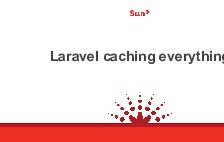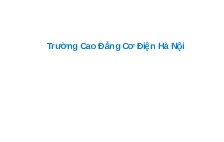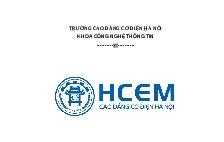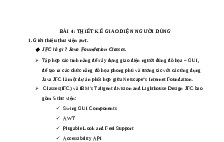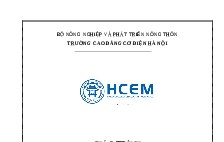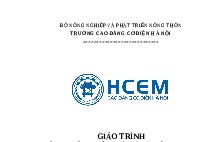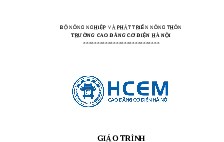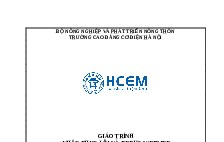SQLServerCh01
Nội dung tài liệu
Tải xuống
Link tài liệu:
Các tài liệu liên quan
Có thể bạn quan tâm
Thông tin tài liệu
Chapter 1
An introduction
to relational databases
and SQL
Murach's SQL Server 2012, C1
© 2012, Mike Murach & Associates, Inc.
Slide 1
Objectives
Knowledge
Identify the three main hardware components of a client/server
system.
Describe the way a client accesses the database on a server using
these terms: application software, data access API, database
management system, SQL query, and query results.
Describe the way a database is organized using these terms: tables,
columns, rows, and cells.
Describe how the tables in a relational database are related using
these terms: primary key and foreign key.
Identify the three types of relationships that can exist between two
tables.
Describe the way the columns in a table are defined using these
terms: data type, null value, default value, and identity column.
Murach's SQL Server 2012, C1
© 2012, Mike Murach & Associates, Inc.
Slide 2
Objectives (cont.)
Describe the relationship between standard SQL and Microsoft SQL
Server’s Transact-SQL.
Describe the difference between DML statements and DDL
statements.
Describe the difference between an action query and a SELECT query.
List three coding techniques that can make your SQL code easier to
read and maintain.
Explain how views and stored procedures differ from SQL statements
that are issued from an application program.
Describe the use of command, connection, and data reader objects
when .NET applications access a SQL Server database.
Murach's SQL Server 2012, C1
© 2012, Mike Murach & Associates, Inc.
Slide 3
A simple client/server system
Database server
`
Network
Client
`
Client
`
Client
Murach's SQL Server 2012, C1
© 2012, Mike Murach & Associates, Inc.
Slide 4
The three hardware components
of a client/server system
Clients
Server
Network
Terms to know
Local area network (LAN)
Wide area network (WAN)
Enterprise system
Murach's SQL Server 2012, C1
© 2012, Mike Murach & Associates, Inc.
Slide 5
Client software, server software,
and the SQL interface
SQL queries
`
Results
Client
Database server
Application software
Data access API
Database management system
Database
Murach's SQL Server 2012, C1
© 2012, Mike Murach & Associates, Inc.
Slide 6
Server software
Database management system (DBMS)
The DBMS does the back-end processing
Client software
Application software
Data access API (application programming interface)
The client software does the front-end processing
Murach's SQL Server 2012, C1
© 2012, Mike Murach & Associates, Inc.
Slide 7
The SQL interface
The application software communicates with the DBMS by
sending SQL queries through the data access API.
When the DBMS receives a query, it provides a service like
returning the requested data (the query results) to the client.
SQL stands for Structured Query Language, which is the standard
language for working with a relational database.
Murach's SQL Server 2012, C1
© 2012, Mike Murach & Associates, Inc.
Slide 8
Client/server system
Processing is divided between client and server
File-handling system
All processing is done on the clients
Murach's SQL Server 2012, C1
© 2012, Mike Murach & Associates, Inc.
Slide 9
A Windows-based system
that uses an application server
User request
SQL queries
`
Response
Client
User interface
Murach's SQL Server 2012, C1
Results
Application Server
Database Server
Business components
DBMS
Database
© 2012, Mike Murach & Associates, Inc.
Slide 10
A simple web-based system
User request
`
User request
SQL queries
Internet
Response
Response
Results
Client
Web Server
Database Server
Web browser
Web applications
Web services
DBMS
Database
Murach's SQL Server 2012, C1
© 2012, Mike Murach & Associates, Inc.
Slide 11
Other client/server system architectures
Application servers store business components
Web servers store web applications and web services
Murach's SQL Server 2012, C1
© 2012, Mike Murach & Associates, Inc.
Slide 12
How web applications work
A web browser on a client sends a request to a web server.
The web server processes the request.
The web server passes any requests for data to the database server.
The database server returns the results to the web server.
The web server returns a response to the browser.
Murach's SQL Server 2012, C1
© 2012, Mike Murach & Associates, Inc.
Slide 13
The Vendors table in an Accounts Payable (AP)
database
Primary key
Columns
Rows
Murach's SQL Server 2012, C1
© 2012, Mike Murach & Associates, Inc.
Slide 14
Terms
Relational database
Table
Column
Row
Cell
Primary key
Composite primary key
Non-primary key (unique key)
Index
Murach's SQL Server 2012, C1
© 2012, Mike Murach & Associates, Inc.
Slide 15
The relationship between two tables
Primary key
Foreign key
Murach's SQL Server 2012, C1
© 2012, Mike Murach & Associates, Inc.
Slide 16
Terms
Foreign key
One-to-many relationship
One-to-one relationship
Many-to-many relationship
Murach's SQL Server 2012, C1
© 2012, Mike Murach & Associates, Inc.
Slide 17
The columns of the Invoices table
Murach's SQL Server 2012, C1
© 2012, Mike Murach & Associates, Inc.
Slide 18
Common SQL Server data types
bit
int, bigint, smallint, tinyint
money, smallmoney
decimal, numeric
float, real
datetime, smalldatetime
char, varchar
nchar, nvarchar
Murach's SQL Server 2012, C1
© 2012, Mike Murach & Associates, Inc.
Slide 19
Terms
Data type
Null value
Default value
Identity column
Murach's SQL Server 2012, C1
© 2012, Mike Murach & Associates, Inc.
Slide 20
An introduction
to relational databases
and SQL
Murach's SQL Server 2012, C1
© 2012, Mike Murach & Associates, Inc.
Slide 1
Objectives
Knowledge
Identify the three main hardware components of a client/server
system.
Describe the way a client accesses the database on a server using
these terms: application software, data access API, database
management system, SQL query, and query results.
Describe the way a database is organized using these terms: tables,
columns, rows, and cells.
Describe how the tables in a relational database are related using
these terms: primary key and foreign key.
Identify the three types of relationships that can exist between two
tables.
Describe the way the columns in a table are defined using these
terms: data type, null value, default value, and identity column.
Murach's SQL Server 2012, C1
© 2012, Mike Murach & Associates, Inc.
Slide 2
Objectives (cont.)
Describe the relationship between standard SQL and Microsoft SQL
Server’s Transact-SQL.
Describe the difference between DML statements and DDL
statements.
Describe the difference between an action query and a SELECT query.
List three coding techniques that can make your SQL code easier to
read and maintain.
Explain how views and stored procedures differ from SQL statements
that are issued from an application program.
Describe the use of command, connection, and data reader objects
when .NET applications access a SQL Server database.
Murach's SQL Server 2012, C1
© 2012, Mike Murach & Associates, Inc.
Slide 3
A simple client/server system
Database server
`
Network
Client
`
Client
`
Client
Murach's SQL Server 2012, C1
© 2012, Mike Murach & Associates, Inc.
Slide 4
The three hardware components
of a client/server system
Clients
Server
Network
Terms to know
Local area network (LAN)
Wide area network (WAN)
Enterprise system
Murach's SQL Server 2012, C1
© 2012, Mike Murach & Associates, Inc.
Slide 5
Client software, server software,
and the SQL interface
SQL queries
`
Results
Client
Database server
Application software
Data access API
Database management system
Database
Murach's SQL Server 2012, C1
© 2012, Mike Murach & Associates, Inc.
Slide 6
Server software
Database management system (DBMS)
The DBMS does the back-end processing
Client software
Application software
Data access API (application programming interface)
The client software does the front-end processing
Murach's SQL Server 2012, C1
© 2012, Mike Murach & Associates, Inc.
Slide 7
The SQL interface
The application software communicates with the DBMS by
sending SQL queries through the data access API.
When the DBMS receives a query, it provides a service like
returning the requested data (the query results) to the client.
SQL stands for Structured Query Language, which is the standard
language for working with a relational database.
Murach's SQL Server 2012, C1
© 2012, Mike Murach & Associates, Inc.
Slide 8
Client/server system
Processing is divided between client and server
File-handling system
All processing is done on the clients
Murach's SQL Server 2012, C1
© 2012, Mike Murach & Associates, Inc.
Slide 9
A Windows-based system
that uses an application server
User request
SQL queries
`
Response
Client
User interface
Murach's SQL Server 2012, C1
Results
Application Server
Database Server
Business components
DBMS
Database
© 2012, Mike Murach & Associates, Inc.
Slide 10
A simple web-based system
User request
`
User request
SQL queries
Internet
Response
Response
Results
Client
Web Server
Database Server
Web browser
Web applications
Web services
DBMS
Database
Murach's SQL Server 2012, C1
© 2012, Mike Murach & Associates, Inc.
Slide 11
Other client/server system architectures
Application servers store business components
Web servers store web applications and web services
Murach's SQL Server 2012, C1
© 2012, Mike Murach & Associates, Inc.
Slide 12
How web applications work
A web browser on a client sends a request to a web server.
The web server processes the request.
The web server passes any requests for data to the database server.
The database server returns the results to the web server.
The web server returns a response to the browser.
Murach's SQL Server 2012, C1
© 2012, Mike Murach & Associates, Inc.
Slide 13
The Vendors table in an Accounts Payable (AP)
database
Primary key
Columns
Rows
Murach's SQL Server 2012, C1
© 2012, Mike Murach & Associates, Inc.
Slide 14
Terms
Relational database
Table
Column
Row
Cell
Primary key
Composite primary key
Non-primary key (unique key)
Index
Murach's SQL Server 2012, C1
© 2012, Mike Murach & Associates, Inc.
Slide 15
The relationship between two tables
Primary key
Foreign key
Murach's SQL Server 2012, C1
© 2012, Mike Murach & Associates, Inc.
Slide 16
Terms
Foreign key
One-to-many relationship
One-to-one relationship
Many-to-many relationship
Murach's SQL Server 2012, C1
© 2012, Mike Murach & Associates, Inc.
Slide 17
The columns of the Invoices table
Murach's SQL Server 2012, C1
© 2012, Mike Murach & Associates, Inc.
Slide 18
Common SQL Server data types
bit
int, bigint, smallint, tinyint
money, smallmoney
decimal, numeric
float, real
datetime, smalldatetime
char, varchar
nchar, nvarchar
Murach's SQL Server 2012, C1
© 2012, Mike Murach & Associates, Inc.
Slide 19
Terms
Data type
Null value
Default value
Identity column
Murach's SQL Server 2012, C1
© 2012, Mike Murach & Associates, Inc.
Slide 20


